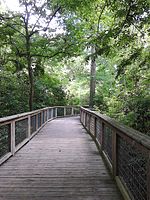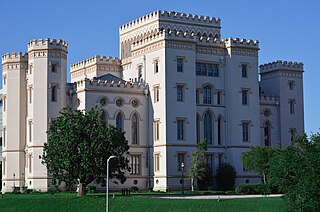
Baton Rouge is the capital city of the U.S. state of Louisiana. Located on the eastern bank of the Mississippi River, it had a population of 227,470 as of 2020; it is the seat of Louisiana's most populous parish (county-equivalent), East Baton Rouge Parish, and the center of Louisiana's second-largest metropolitan area, Greater Baton Rouge.

Arcata is a city adjacent to the Arcata Bay (northern) portion of Humboldt Bay in Humboldt County, California, United States. At the 2020 census, Arcata's population was 18,857. Arcata was first founded in 1850 as Union, was officially established in 1858, and was renamed Arcata in 1860. It is located 280 miles (450 km) north of San Francisco, and is home to California State Polytechnic University, Humboldt. Arcata is also the location of the Arcata Field Office of the Federal Bureau of Land Management, which is responsible for the administration of natural resources, lands and mineral programs, including the Headwaters Forest, on approximately 200,000 acres (810 km2) of public land in Northwestern California.

Bird ringing (UK) or bird banding (US) is the attachment of a small, individually numbered metal or plastic tag to the leg or wing of a wild bird to enable individual identification. This helps in keeping track of the movements of the bird and its life history. It is common to take measurements and examine conditions of feather molt, subcutaneous fat, age indications and sex during capture for ringing. The subsequent recapture or recovery of the bird can provide information on migration, longevity, mortality, population, territoriality, feeding behavior, and other aspects that are studied by ornithologists. Other methods of marking birds may also be used to allow for field based identification that does not require capture.

The marbled murrelet is a small seabird from the North Pacific. It is a member of the family Alcidae, which includes auklets, guillemots, murres and puffins. It nests in old-growth forests or on the ground at higher latitudes where trees cannot grow. The marbled murrelet has declined in number since humans began logging its nest trees in the latter half of the 19th century. The decline of the marbled murrelet and its association with old-growth forests, at least in the southern part of its range, have made it a flagship species in the forest preservation movement.

Jean Saint Malo in French, also known as Juan San Maló in Spanish, was the leader of a group of runaway enslaved Africans, known as Maroons, in Spanish Louisiana.

The Magnolia Mound Plantation House is a French Creole house constructed in 1791 near the Mississippi River in Baton Rouge, Louisiana. Many period documents refer to the plantation as Mount Magnolia. The house and several original outbuildings on the grounds of Magnolia Mound Plantation are examples of the vernacular architectural influences of early settlers from France and the West Indies. The complex is owned by the city of Baton Rouge and maintained by its Recreation Commission (BREC). It is located approximately one mile south of downtown.
The Southeastern Arizona Bird Observatory (SABO) is a nonprofit membership-supported scientific and educational organization founded in 1996 in Bisbee, Arizona, USA. The mission of the Southeastern Arizona Bird Observatory is to promote the conservation of the birds of southeastern Arizona, their habitats, and the diversity of species that share those habitats through research, monitoring, and public education. The observatory's founders are Tom Wood and Sheri Williamson, former managers of The Nature Conservancy's Ramsey Canyon Preserve.

Quercus vacciniifolia, the huckleberry oak, is a member of the Protobalanus section of genus Quercus. It has evergreen foliage, short styles, very bitter acorns that mature in 18 months, and a woolly acorn shell interior.

Cat Island National Wildlife Refuge was established on October 27, 2000, as the 526th refuge in the United States National Wildlife Refuge System. It is located near the town of St. Francisville, Louisiana, which is 30 miles (48 km) north of Baton Rouge. The refuge was established to conserve, restore, and manage native forested wetland habitats for migratory birds, aquatic resources, and endangered and threatened plants and animals. Additionally, it was created to encourage the use of volunteers and facilitate partnerships among the U.S. Fish and Wildlife Service, local communities, and conservation organizations to promote public awareness of resources of the refuge and the National Wildlife Refuge System.
The culture of Louisiana involves its music, food, religion, clothing, language, architecture, art, literature, games, and sports. Often, these elements are the basis for one of the many festivals in the state. Louisiana, while sharing many similarities to its neighbors along the Gulf Coast, is unique in the influence of Louisiana French culture, due to the historical waves of immigration of French-speaking settlers to Louisiana. Likewise, African-American culture plays a prominent role. While New Orleans, as the largest city, has had an outsize influence on Louisiana throughout its history, other regions both rural and urban have contributed their shared histories and identities to the culture of the state.

A duck decoy is a man-made object resembling a real duck. Duck decoys are sometimes used in waterfowl hunting to attract real ducks.
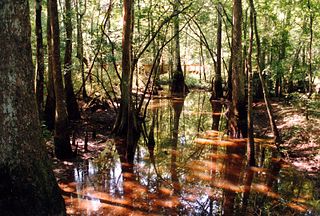
Tickfaw State Park, located 7 mi (11 km) west of Springfield, in Livingston Parish, Louisiana, United States, opened in May 1999 and quickly became one of Louisiana's most popular state parks because of its natural setting, recreation opportunities, and proximity to the state's two cities: New Orleans and Baton Rouge. The park contains a nature center, picnic shelters, a large fishing pond, 14 cabins, and 50 campsites.
A blue bonnet is a type of soft woollen hat that was the customary working wear of Scottish labourers and farmers.
The North American Bird Banding Program (NABBP), along with its Bird Banding Laboratory (BBL), has its home at the Patuxent Wildlife Research Center. The program is jointly administered by the Canadian Wildlife Service and the United States Geological Survey. The program is responsible for many aspects of bird banding in the United States and Canada: it grants permits to bird banders, fills orders for bands of various sizes, collects data from banding stations, receives reports from people who have found birds carrying bands, and makes its database available to appropriate parties.
The Louisiana Geological Survey is a state geological survey established by the Louisiana legislature by Act 131 in 1934 to serve the citizens Louisiana by collecting, preserving, and disseminating impartial information on the geomorphology, hydrogeology, geology, paleontology, economic geology, and geological resources of Louisiana. The Louisiana Geological Survey was originally part of the Louisiana Department of Conservation. Later it was a division of the Louisiana Department of Natural Resources and finally transferred by the Louisiana legislature's HB 2353 to Louisiana State University. At Louisiana State University, it is part of the Office of Research and Economic Development.
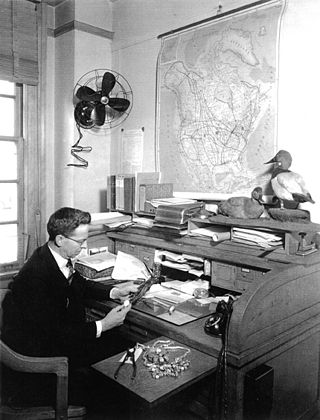
Frederick Charles Lincoln was an American ornithologist.

Ralph R. Perlman was the state budget director in his adopted U.S. state of Louisiana, having served under four governors of both parties from 1967 until 1988. Thereafter, Perlman continued to hold other public service positions.
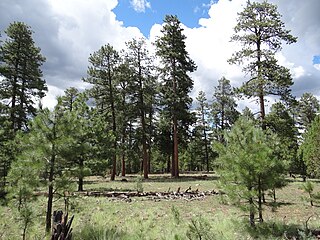
Ponderosa pine forest is a plant association and plant community dominated by ponderosa pine and found in western North America. It is found from the British Columbia to Durango, Mexico. In the south and east, ponderosa pine forest is the climax forest, while in the more northern part of its range, it can transition to Douglas-fir or grand fir, or white fir forests. Understory species depends on location. Fire suppression has led to insect outbreaks in ponderosa pine forests.
St. George is a proposed city in Louisiana that was approved in a ballot initiative on October 12, 2019. Upon incorporation, it would become the fifth largest city in Louisiana and the second largest in East Baton Rouge Parish with a population of 86,316. The proposed city originates from a previously unincorporated area of East Baton Rouge Parish located southeast of the City of Baton Rouge.
